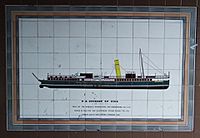PS Duchess of Fife (1903) facts for kids
PS Duchess of Fife was a special paddle steamer built way back in 1903. She spent most of her time carrying passengers around the beautiful Firth of Clyde in Scotland. But this ship was more than just a passenger ferry! During both World War I and World War II, she was called into action by the British Navy to help clear dangerous underwater mines. In 1940, she played a very important role in the Dunkirk evacuation, helping to rescue over 1,600 Allied soldiers. After serving for 50 years, she was finally taken apart for scrap in 1953.

A mosaic of the Duchess of Fife in a Greenock underpass
|
|
Quick facts for kids History |
|
|---|---|
| Name |
|
| Owner |
|
| Operator |
|
| Builder | |
| Yard number | 432 |
| Launched | 9 May 1903 |
| Honours and awards |
Dunkirk 1940 |
| Fate | Scrapped, 15 September 1953 |
| General characteristics | |
| Type | Paddle steamer |
| Tonnage | 336 GRT |
| Length | 213.3 feet (65.0 m) |
| Propulsion | Triple expansion diagonal |
| Speed | 17 knots |
Contents
Building the Duchess of Fife
The Duchess of Fife was built by a company called Fairfield Shipbuilding and Engineering Company. This company was located in Govan, Glasgow, Scotland. She was launched into the water on May 9, 1903. Her engines were designed similarly to another ship from the same company, the PS Duchess of Montrose.
A Ship's Life: Service History
Early Passenger Journeys
The Duchess of Fife started her life carrying passengers. Her main routes were from Gourock to places like Dunoon and Rothesay. These were popular travel routes in Scotland.
Serving in World War I
In May 1916, during World War I, the British Navy needed her help. She was changed into a minesweeper, a ship that clears dangerous underwater mines. Her name was shortened to HMS Duchess for this special duty. She worked in the North Sea, helping to keep the waters safe. After the war, in April 1919, she went back to being a passenger ship. From 1937, she sailed from Wemyss Bay to Millport and Kilchattan Bay.
Helping in World War II
When World War II started in 1939, the Duchess of Fife was called to serve again. This time, she kept her full name, HMS Duchess of Fife. She joined a group of minesweepers based in Harwich.
The Dunkirk Evacuation
One of her most famous missions was "Operation Dynamo," also known as the Dunkirk evacuation. This was a huge rescue mission in 1940. From May 28, the Duchess of Fife made four trips between Dunkirk and Ramsgate. She helped rescue a total of 1,633 Allied soldiers! Her last trip was on June 3, carrying 300 French troops to safety. Because of her bravery, she later received a special award called a Royal Navy battle honour.
Later that year, the Duchess of Fife moved to Kingston upon Hull. From there, she became a training ship for minesweeping. She helped teach new sailors at a place called HMS Lochinvar in Port Edgar.
Returning to Civilian Life and Retirement
In 1945, after the war, she was fixed up by James Lamont & Co in Greenock. She then went back to carrying passengers. The Duchess of Fife's very last journey was on June 6, 1953. In September 1953, after 50 years of service, she was sold to a company in Port Glasgow to be taken apart for scrap.

